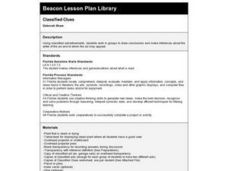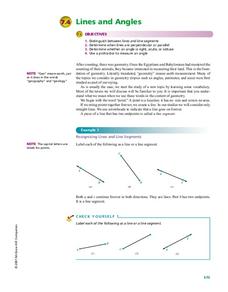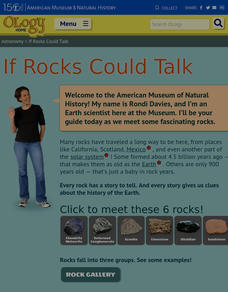Curated OER
Lesson 11: Comprehending the Classified Ads
In this language arts worksheet, students receive direct instruction in how to read and comprehend newspaper classified advertisements. They reflect and review after reading the advertisements. They explore different sections of the...
Curated OER
Classified Cues
Students analyze classified advertisements to make inferences about who wrote the ad and who may find the ad appealing. They write their own classified ads based on what they have learned.
Curated OER
Evaluating Information Resources
Students identify at least five aspects to be examined in determining the validity of information presented on a website. They classify websites into highly trustable, trustable or questionable information sources. In addition, they...
Curated OER
What's The Idea?
Quite often, learners confuse the main idea in a selection of reading with the supporting details. In this activity, pupils practice the skill of finding the main idea and the supporting details in pieces of writing. Newspaper articles...
Curated OER
Ornithology and Real World Science
Double click that mouse because you just found an amazing lesson! This cross-curricular Ornithology lesson incorporates literature, writing, reading informational text, data collection, scientific inquiry, Internet research, art, and...
Illustrative Mathematics
What is a Trapezoid? (Part 1)
Challenge your class to construct a definition for trapezoids. Looking at four examples and four non-examples, students individually create definitions and use them to classify an unknown shape. Allow for small group and whole-class...
McGraw Hill
Lines and Angles
Why was the obtuse angle upset? Because it was never right! A valuable resource is loaded with background information on types of angles and lines. Learners review the characteristics of parallel, perpendicular, and intersecting lines,...
Cornell University
Insect IPM
Find out the characteristics that makes a bug an insect with a workbook designed to inform scholars about the crawly creatures that live around us. Scholars complete an ant-themed word search, answer questions using a solution key, and...
Curated OER
Classifying Lesson Plan
Young scholars classify objects according to their similar characteristics.
Curated OER
Pebbles, Sand and Silt -- Categorizing Fiction and Informational Books
Primary readers complete the activities in a Pebbles, Sand and Silt FOSS kit. As a class, they are given a group of rocks and they are to categorize them based on their activities in the FOSS kit. They use this information and apply it...
National Security Agency
Classifying Triangles
Building on young mathematicians' prior knowledge of three-sided shapes, this lesson series explores the defining characteristics of different types of triangles. Starting with a shared reading of the children's book The Greedy Triangle,...
Howard Hughes Medical Institute
Sorting Seashells
Scientists use morphological, physiological, and molecular information to continually revise organism classification. Scholars observe and learn about 20 shells. Then, they work to sort and classify the shells, building a taxonomy based...
Cold Spring Harbor Laboratory
Some Viruses Store Genetic Information in RNA
Can a high school program alter the entire course of your life? David Baltimore and Howard Temin participated in high school programs working in research laboratories and went on to win the 1975 Nobel Prize. Learn about these two...
American Museum of Natural History
If Rocks Could Talk
Meet some interesting rocks. Learners discover information about the three types of rocks and different rocks that are within each group. They read imaginary interviews with six rocks as each rock tells the story of their formation and a...
Berkshire Museum
Backyard Rocks
You don't have to travel far to learn about rocks, just step outside, pick up a stone, and begin investigating. After taking a class walk around the school grounds collecting rocks, young scientists practice their skills of observation...
Curated OER
Insects and Bugs
Students recognize the difference between insects and bugs while making connections to personal experiences. In this insect and bug instructional activity, students complete a pre-assessment to demonstrate prior knowledge, then gather...
Curated OER
Multiple Perspectives: Newspaper Stories and Editorials
Newspapers are the perfect medium through which to explore different perspectives in informational text. After researching the fur trade and resultant colonization, groups write a newspaper, including an editorial page, selecting one of...
University of Delaware
Constructing Text-Based Arguments About Social Issues
Eighth graders take a stand on a variety of controversial topics with a lesson on argumentative writing. As they view an informative presentation and work with collaborative groups, they decide which side of each argument they want to...
Curated OER
Classifying Dog Breeds
Students classify dog breeds. In this animal science lesson, students research various breeds of dogs on the Internet and classify breeds into small, medium, and large breeds. Students illustrate their classification notes with pictures.
Curated OER
Classifying Stars and Constellations
Students examine stars and constellations. In this space science instructional activity, students visit selected websites to discover information about the classification of stars. Students also practice identifying constellations.
Curated OER
School-Home Links: Fiction, Encyclopedias, Atlases
In this classifying information and parent communication form worksheet, students write where they would look to find the information listed. Students options are fiction, encyclopedia, or atlas. Students must also get their parent or...
Curated OER
The Dinosaur Diner
Students explore the food chain. In this dinoaur lesson, students identify charactersitics of an omnivore, carnivore, and herbivore. Students sort dinosaur picture/word cards into groups by their eating characteristics. Students also...
Curated OER
Discovering Dichotomous Keys
Students become familiar with the structure and use of dichotomus keys. They demonstrate a comprehension of the fundamental principles of taxonomy by classifying organisms from a local ecosystem. Students are introduced to the term...
Curated OER
Harriman and Plant Identification
Students observe and record botanical details from the plant specimens. They identify plants using sorting key and field guide and classify specimens for preservation and display purposes.

























